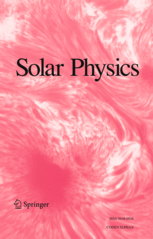
outdated Calls for Papers
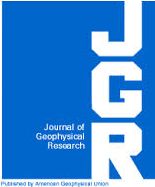
updated on Sep 22, 2020
by Yoshizumi Miyoshi
Journal of Geophysical Research
Special section dedicated to
Geospace multi-point observations
in Van Allen Probes and Arase era
The process of submission is open
Deadline
for paper submission: September 30, 2020
December 31, 2020
Special section description:
In Van Allen Probes and Arase era, coordinated multi-point observations with satellites in space and ground-based observatories have been organized in order to improve our understanding of the physical mechanisms of dynamics of geospace environment. This special issue expands upon new findings from these coordinated observations of Van Allen Probes, Arase and ground-based networks as well as interplay among different missions. There have been several storm events during periods of coordinated observations of both Van Allen Probes and Arase satellites; May 2017, July 2017, September 2017, and August 2018, which will be campaign study events from the multi-satellite and ground based observations in this special issue. Moreover, multi-point observations to focus on wave-particle interactions, for example, ULF observations at different MLTs and whistler/EMIC wave observations at different magnetic latitudes have also been planned, which are also good subjects for this special issue. Results from related observations and modeling/simulation studies on the inner magnetosphere are also welcome.
Instructions for submission:
Please use AGU GEMS system ( https://jgr-spacephysics-submit.agu.org/cgi-bin/main.plex) to submit your manuscript.
We look forward to many articles for this special section.
* Yoshi Miyoshi (ISEE, Nagoya University, miyoshi[at]isee.nagoya-u.ac.jp)
* Iku Shiokawa (ISAS/JAXA, iku[at]stp.isas.jaxa.jp)
* Kazuo Shiokawa (ISEE, Nagoya University, shiokawa[at]isee.nagoya-u.ac.jp)
* Sasha Ukhorskiy (JHU/APL, Sasha.Ukhorskiy[at]jhuapl.edu)
* Ondrej Santolik (Czech Academy of Sciences, ondrej.santolik[at]mff.cuni.cz)
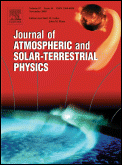
by Kazuo Shiokava
VarSITI co chair
JASTP special issue
dedicated to the
Variability of the Sun and Its Terrestrial Impact (VarSITI)
Completion Symposium 2019
The process of submission is open
Look for the instructions below
Deadline
for paper submission: November 30th, 2019
has been extended to February 28th, 2020
Dear Colleagues,
On behalf of guest editors, I would like to invite you to submit papers to the Special Issue of Variability of the Sun and Its Terrestrial Impact (VarSITI) Completion Symposium 2019 in Journal of Atmospheric and Solar-Terrestrial Physics (JASTP). The symposium was held on June 10÷14, 2019 at Sofia, Bulgaria. Because this special issue is one of the summarizing activities of the 5-year VarSITI program (2014÷2018), we also welcome submission of papers from those who made presentation at the SCOSTEP's STP-14 conference (July 9÷13, 2018, Toronto, Canada), and also from scientists who did not join these two symposiums..
The VarSITI program (http://www.varsiti.org/) was the 5-year international program of SCOSTEP (Scientific Committee On Solar-TErrestrial Physics) in 2014-2018. VarSITI focused on the recent and expected future solar activity and its consequences for the Earth, for various time scales from the order of thousands years to milliseconds, and for various locations and their connections from the solar interior to the Earth’s atmosphere. Four Scientific Projects were carried out under the VarSITI program: (1) Solar Evolution and Extrema (SEE), (2) International Study of Earth-Affecting Solar Transients (ISEST/MiniMax24), (3) Specification and Prediction of the Coupled Inner-Magnetospheric Environment (SPeCIMEN), and (4) Role Of the Sun and the Middle atmosphere / thermosphere / ionosphere In Climate (ROSMIC). These four projects were carried out in collaboration with relevant satellite and ground-based missions as well as modeling efforts to facilitate the implementation of these projects. The special issue welcomes new and interdisciplinary scientific results related to this 5-year VarSITI program.
Instructions for submission:
1) The submission website is https://www.evise.com/profile/#/ATP/login (you must have EVISE account)
- Log in with EVISE account,
- choose Start New Submission.
2) During the submission process, author will be asked to choose an Article Type.
Choose VSI: (VarSITI2019 and STP-14)
Looking forward to your contributions,
*Kazuo Shiokawa (Institute for Space-Earth Environmental Research, Nagoya University, Japan)
*Rositsa Miteva (Space Research and Technology Institute, Bulgarian Academy of Sciences, Bulgaria)
*Sergio Dasso (Universidad de Buenos Aires, Instituto de Astronomiay Fisica del Espacio (IAFE), Buenos Aires, Argentina)
*Shunrong Zhang (MIT Haystack Observatory, USA)
*Duggirala Pallamraju (Physical Research Laboratory, Navrangpura, Ahmedabad, India)
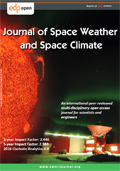
by Patricia Doherty
SCOSTEP Secretary
Journal of Space Weather and Space Climate
Topical Issue:
"Space climate: The past and future of solar activity"
Deadline for paper submission:
March 31, 2020
Dear colleagues,
The Journal of Space Weather and Space Climate (JSWSC) accepts submission of research manuscripts for a Topical Issue on "Space climate: The past and future of solar activity" to appear in 2020. This is an open call for papers discussing any aspect of Space Climate, i.e., the long-term change in the Sun and its effects in the heliosphere and the near-Earth space environment, including solar effects on the atmosphere and climate.
For more information, see this page
Please note that the deadline for submitting papers has been extended to March 31, 2020. No additional delay will ensue from this extension since each paper will be treated and published individually at the pace of its own refereeing process. Note that early submission may even avoid the rush around the deadline and lead to faster publication.
For submission, start with the following website: https://www.editorialmanager.com/jswsc/default.aspx
With best regards,
Kalevi Mursula, University of Oulu, Finland
Paul Charbonneau, University of Montreal, Canada
Agnieszka Gil-Swiderska, University of Natural Sciences and Humanities in
Siedlce, Poland
Natalie Krivova, Max-Planck-Institut für Sonnensystemforschung, Germany
Ilya Usoskin, University of Oulu, Finland
by Aleksandra Nina
guest editor
Sustainability - Open Access Journal special issue
Natural Disasters and Extreme Solar Energy
Dear VarSITI colleagues,
We would like to invite you to submit articles for the Special Issue
"Natural Disasters and Extreme Solar Energy"
(more)
of the journal
![]() - (indexed by WoS-SSCI,
IF2017: 2.685 and Scopus: Q1).
- (indexed by WoS-SSCI,
IF2017: 2.685 and Scopus: Q1).
Papers should be submitted via MDPI system: https://susy.mdpi.com/ Guides for authors can be found on the web: (https://www.mdpi.com/journal/sustainability/instructions)
The submission deadline for this specific call for articles is on 31 December 2019
.
Important! During submission process, please, select Special Issue: Natural Disasters and Extreme Solar Energy.
Special Issue Information. The atmosphere is a very sensitive medium to extraterrestrial forces, most importantly, solar electromagnetic radiation and energetic particle intrusion. This released intense solar activity can cause sudden disturbances in the Earth's atmosphere and further create ground telecommunication interferences, blackouts, transportation problems, water supply problems, potential health effects, as well as natural disasters, such as forest fires. These extreme events can cause billions of dollars of damage and impact individuals, families, communities, and societies. For this reason, it is of crucial importance to investigate the connections between this extreme activity, natural disasters, and further develop ways to prevent, prepare against, and respond to them. The aim of this Special Issue is to engage a wide community of scientists to defragment and expend current knowledge in this field.
We would like to invite you to submit review-papers, case studies, or research articles that formulate innovative approaches related to this field so that these results can be used by other scientists as well as engineers and other people employed in the industry. Potential topics include but are not limited to:
- Natural hazards;
- Solar activity;
- Fires;
- Atmosphere modeling and forecasting;
- Remote sensing;
- Public health;
- Transportation safety;
- Telecommunication disturbances;
and other topics that connect risk, disasters, and sustainability.
Aleksandra Nina, Milan Radovanovic and Vladimir Sreckovic
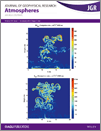
JGR Atmosphere-Space Physics special issue:
Long term changes and trends in the middle and upper atmosphere
Please consider submitting your work to the JGR Atmosphere-Space Physics special issue: Long term changes and trends in the middle and upper atmosphere.
The section description is as follows::
This special issue is inspired by the recent 10th Trend Workshop in May 2018, but is open to all relevant submissions. Long-term changes to Earth's middle and upper atmosphere are becoming more and more relevant to the future of our world and it is paramount that we quantify and understand changes occurring at all levels within the coupled atmospheric system. The increasing concentration of greenhouse gases, stratospheric ozone depletion, varying solar and geomagnetic activity, secular change of Earth's magnetic field, and changing dynamics propagating up from the troposphere are some of the possible causes of long-term changes in the stratosphere, mesosphere, thermosphere and ionosphere. The goals of this workshop are to review the current state of knowledge about trends in these atmospheric regions, and to discuss what research is necessary for resolving inconsistencies, reducing uncertainties, and achieving a deeper understanding of middle and upper atmospheric climate change - especially the relative influences of anthropogenic and solar effects. Topics on long-term variations of the middle and upper atmosphere and ionosphere such as QBO, ENSO, MJO are all welcomed.
Authors are to submit through the
- GEMS site for JGR: Space Physics at https://jgr-spacephysics-submit.agu.org or for
- JGR: Atmospheres at https://jgr-atmospheres-submit.agu.org.
For additional information please contact jgr-spacephysics[at]agu.org and jgr-atmospheres[at]agu.org
ORCIDS will now be required for all corresponding authors and strongly encouraged for coauthors.
AGU officially joins with a number of other publishers in a commitment to include the ORCID (Open Researcher and Contributor ID) for authors of all papers published. See statement here
All AGU journal content from 1997 to 24 months ago is freely available online. Your published paper will become fully open 24-months after publication.
We look forward to many articles for this special section,
Special section organizers:
Jia Yue, Tao Li, Shunrong Zhang, Liying Qian, Jan Lastovicka
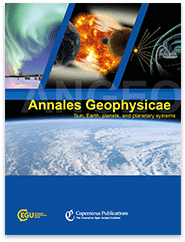
by Petra Koucká Knížova
guest editor
Anales Geophysicae special issue:
Vertical coupling in the atmosphere–ionosphere system
Dear colleagues,
Let me kindly remindyou that special issue entitled "Vertical coupling in the atmosphere–ionosphere system" has been accepted as part of the
journal ANGEO. Authors are invited to submit their contributions by
using the online registration form on the ANGEO website:
https://www.annales-geophysicae.net/about/aims_and_scope.html.
The deadline for submission is 15 Feb 2019.
The guest editors are C. Jacobi, P. Koucká Knížova, E. Yigit, C. Arras, K. Baumgarten, and W. Ward.
NOTE: During the registration process it is important that the correct special issue is chosen!!!
We look forward to many articles for this special issue,
Best regards, Petra Koucká Knížova

Special Section for
Initial results of the ERG(Arase) project and multi-point observations
We are very pleased to announce that the Geophysical Research Letters (GRL) will be soon accepting paper submissions to the Special Section for Initial results of the ERG(Arase) project and multi-point observations.
Special section description:
The Arase (ERG) mission has been exploring the Earth's inner
magnetosphere, in particularly, the Van Allen radiation belts with six
sets of onboard particle analyzers and two sets of onboard
electromagnetic field measurements since its launch on December 20,
2016. The major purpose of the Arase mission is to study acceleration,
transport, and loss processes of radiation belt particles and dynamics
of the inner magnetosphere. One major characteristic of the Arase's
observation strategy is that various kinds of ground-based coordinated
observations has been carefully prepared. Coordinated multi-point
observations with satellites in space and ground-based observatories
must contribute comprehensive understandings of physical mechanism of
dynamically variation geospace environment. Indeed, Arase and its
coordinated measurements in geospace has successfully observed several
severe geospace storm events. This special issue expands upon new
findings from these observations of Arase and ground-based networks as
well as interplay among different missions. Results from related
observations and modeling/simulation studies on the inner
magnetosphere are also welcome.
Please use AGU GEMS system (https://grl-submit.agu.org/cgi-bin/main.plex) to submit your manuscript.
We look forward to many articles for this special section,
Yoshi Miyoshi (ISEE, Nagoya Uni., miyoshi[at]isee.nagoya-u.ac.jp)
Iku Shiokawa (ISAS/JAXA, iku[at]stp.isas.jaxa.jp)
Kazuo Shiokawa (ISEE, Nagoya Uni., shiokawa[at]isee.nagoya-u.ac.jp)
Shiang-Yu. Wang (ASIAA, swwang[at]asiaa.sinica.edu.tw)

Special collection in the Space Weather journal
the strong-to-severe space weather of 4-10 September 2017
Dear VarSITI colleagues,
1 May 2018
Contact spaceweather[at]agu.org for details.
or see Space Weather Special Issues
The editors of Space Weather are organizing a special collection to highlight the strong-to-severe space weather of 4-10 September 2017. This interval was one of the most flare-productive periods of now-waning solar cycle 24. Solar active regions (AR) 2673 and 2674 both matured to complex magnetic configurations as they transited the disk. AR2673 transformed from a simple sunspot on 2 September to a complex region with order-of-magnitude growth on 4 September, rapidly reaching beta-gamma-delta configuration. In subsequent days the region issued three X-class flares and multiple partial halo ejecta. Combined, the two active regions produced more than a dozen M-class flares. As a parting shot AR2673 produced: 1) an X-9 level flare; 2) an associated moderate solar energetic particle event; and 3) a ground level event, as it arrived at the solar west limb on 10 September. From 4÷16 September the radiation environment at geosynchronous orbit was at minor storm level and 100 MeV protons were episodically present in geostationary orbit during that time frame. The early arrival of the coronal mass ejection associated with the 6 September X-9 flare produced severe geomagnetic storming on 7 and 8 September. The full set of events was bracketed by high speed streams that produced their own minor-to-moderate geomagnetic storming.
This interval is covered by, perhaps, the best set of heliospheric and space weather instruments every to witness a significant event. We call for papers that address the heliospheric and geospace disturbances, and highlight how ground- and space-based instrumentation, combined with improved models allow us to understand the origin, dynamics and consequences of these storms. We are particularly interested in “effects and impacts” papers, as there have been a number of media reports that HF radio blackouts caused by the X-flares disrupted emergency communications vital to recovery efforts following Hurricane Irma. We also welcome papers that assess the importance of these impacts and any other practical impacts arising from the space weather events in early September 2017. Additionally, we encourage papers that address the direction, propagation and arrival time of the heliospheric structures (shock, sheath and/or core) that led to periods of forecast and/or observed strong southward Bz.
Delores J. Knipp
Editor in Chief
Space Weather
Anticipated decline for submission is 1 March 2018.

JASTP special issue
dedicated to the
Second VarSITI General Symposium
Dear VarSITI members,
Now it is open submission of the manuscripts to the special Issue on the 2nd VarSITI General Symposium in he Journal of Atmospheric and Solar-Terrestrial Physics (JASTP) It's open special Issue and you may submitt the manuscript even if you didn't take part in the meeting.
The deadline will be in February 2018. As we are interesting in collaborative publications it's good opportunity for preparation and submission of the such publications. The instructions is below.
Instructions for submission:
1) The submission website is
http://www.evise.com/evise/jrnl/ATP you must have EVISE account
2) The mandatory files are the manuscript and the highlights (see, explanation here). You cannot finish you submission without the file with the highlights.
3) Please, add **at least 6 candidates** for choosing of reviewers. Mind that this number is bigger than it is mentioned in the submission online form.
We increased that number to ensure the fast refereeing process.
These reviewer candidates
- MUST NOT BE from the institutions where any of the manuscript co-authors are affiliated.
- Also, at least three candidates should be from the country different from the countries of the authors' affiliations.
We expect the reviewer candidates to be experts in the research field of the manuscript.
4) To ensure that all manuscripts are correctly identified for the inclusion in this Special Issue, it is important that the authors select the name of the special issue when they upload their manuscripts: "VSI:Solar-Terrestrial Coupli".
Looking forward to your contributions,
Larisa Kashapova
guest editor

Special Section for
New understanding of the solar eclipse effects on geospace:
the 21 August 2017 Solar Eclipse
Deadline for submission is January 31, 2018
Manuscripts are solicited for the GRL-Special Section on the study of 21 August 2017 solar eclipse effects on geospace The deadline for submission is January 31, 2018. Title of the special section: New understanding of the solar eclipse effects on geospace: the 21 August 2017 Solar Eclipse
Special section description:
A solar eclipse generates dramatic changes throughout the Earth's geospace due to the fast reduction and recovery of solar EUV irradiation. It modifies local and global energetics, dynamics, and the ionospheric ionization supply, leading to substantial changes in the coupled magnetosphere-ionosphere-thermosphere-mesosphere (geospace) system. It is an idealized "active experiment" to explore the impulse-response dynamics of geospace and to address some of the fundamental scientific questions in geospace. The 21 August 2017 solar eclipse provides an unprecedented opportunity for this because of the large amount of observational data obtained during the eclipse with recent major advances in sensitivity, spatial/temporal resolution, and global coverage of measurements, as well as the development of sophisticated geospace modeling tools. This special issue aims at quantifying the new understanding of the solar eclipse effects on geospace. This new understanding includes, but not limited to, global ionospheric and thermospheric changes, responses of neutral composition, temperature, and winds, traveling ionospheric disturbances, geomagnetic and electric field disturbances, localized and meso-scale structures, lower ionospheric changes and associated impacts on VLF/LF/HF radio propagation.
Please use AGU GEMS system (https://grl-submit.agu.org/cgi-bin/main.plex) to submit your manuscript. When preparing your manuscript, it is important to follow the regular GRL data and length requirements. See also GRL submission checklists and templates page for new and revised submissions.
Finally, please note that AGU and its editors are also willing to extend this collection to articles that may be appropriate for JGR-Space Physics [Read full aims and scope], and
Space Weather [Read full aims and scope].
We look forward to many articles for this special section,
Wenbin Wang (NCAR HAO, wbwang[at]ucar.edu)
Shunrong Zhang (MIT Haystack, shunrong[at]mit.edu)
Aaron Ridley (U of Michigan, ridley[at]umich.edu)
Larisa Goncharenko (MIT Haystack, lpg[at]mit.edu)
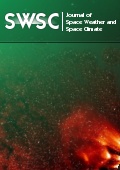
by Olga Malandraki
Topical Editor-in-Chief
J. Space Weather Space Climate
Topical Issue:
"Flares, CMEs and SEPs and their space weather impacts"
Deadline for expression of interest:
15 February 2017
Deadline for submission:
30 April 2017
Dear colleagues,
Flares, Coronal Mass Ejections (CMEs) and their Interplanetary counterparts (ICMEs) remain topics of important research in the field of solar terrestrial relations. Flares can have an important impact (UV radiation, particles) on the Earth's atmosphere. Recent remote observations and modeling studies have shown that coronal mass ejections (CMEs) can drive shock waves very low in the solar corona, which, in turn, may produce significant fluxes of solar energetic particles (SEPs). Interplanetary Coronal Mass Ejections (ICMEs) are the main drivers of large geomagnetic storms.
In this topical issue, we invite observational, theoretical, and modeling contributions that address the following topics:
- - particle acceleration at flares as well as the response of the lower ionosphere to a variety of external forcing during flares, such as energetic particles and solar UV and X-ray variability,
- - the coronal dynamics of CME and shocks in connection with the early production of SEPs
- - the magnetic connectivity and early-stage transport in the heliosphere of SEPs
- - the propagation of coronal mass ejections in the heliosphere, their interaction with Earth and/or with other planets,
- - the link between CMEs and ICMEs, the relation of coronal mass ejections with energetic particles.
This Topical Issue is seen as an outcome of the session on a similar topic organized at the 13th European Space Weather Week in Ostende but is open to any contributions on the subject.
All manuscripts will be peer reviewed according to the quality standards of international scientific journals. The type of contributions must fit the style of SWSC. All manuscripts should contain enough new insight, present the results against a properly referenced background of existing work, and present adequate evidence that supports the conclusions. Accepted papers are published in electronic format only, and are freely available to everyone via the SWSC web site. SWSC offers the possibility to include electronic material, such as animations, movies, codes and data.
The Topical Editors-in-Chief are:
Nicole Vilmer, LESIA, Paris Observatory (Nicole.Vilmer[at]obspm.fr)
Olga Malandraki, IAASARS, National Observatory of Athens (omaland[at]noa.gr)
For questions regarding this topical issue, please contact any of Topical Editors.
For questions concerning the submission process
the Editorial Office should be contacted. (swsc[at]edpsciences.org)
Olga Malandraki
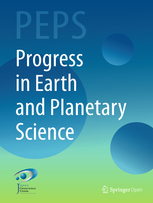
by Kazuo Shiokawa
VarSITI Co-chair
Progress in Earth and Planetary Sciences
Special call:
"Ionospheric Plasma Bubble Seeding and Development"
Dear SCOSTEP/VarSITI colleagues,
We invite you to submit your research work on the subject of “Equatorial ionospheric Plasma Bubble (EPB) seeding and development” to Journal of “Progress in Earth and Planetary Science” (PEPS). This is an outcome of the workshop held at the Institute for Space-Earth Environmental Research (ISEE), Nagoya University, Japan, during November 29 to December 02, 2016. The manuscripts selected after peer review processes will be published as a collection of papers attending to the “Special call for excellent papers on hot topics” (SPEPS) of PEPS. The paper submission is open and welcome for all scientists in the area of Space and Atmospheric sciences.
The article collection will cover the following topics:
(1) EPB seeding and
development: review and new interpretations;
(2) EPB new observational
techniques: optical, radio and in-situ measurements;
(3) EPB simulation models:
current status of development and capability, and future scope; and
(4) EPB and
space weather concerns, now and in the future.
Submission deadline: June 30, 2017
The detail of paper submission to PEPS attending to “Special call for excellent papers on hot topics (SPEPS), i. e., preparation of manuscript, submission process, publication costs etc., can be found at: http://progearthplanetsci.org/index.html wherein you can access the box of “SPEPS”.
Also you can access these information in the PEPS Facebook (https://www.facebook.com/peps.jpgu) and Twitter (https://twitter.com/PEPS_JpGU)
If you have any further questions, please contact: <peps_edit[at]jpgu.org>.
Special topics proponentes:
Dr. Hisao Takahashi (Instituto Nacional de Pesquisas Espaciais (INPE), Brazil)
Dr. Mangalathayil Ali Abdu (Instituto nacional de pesquisas Espaciais (INPE), Brazil)
Dr. Yuichi Otsuka (Institute for Space-Earth Environmental Research (ISEE), Nagoya University, Japan)
Dr. Kazuo Shiokawa (Institute for Space-Earth Environmental Research (ISEE), Nagoya University, Japan)
Associate Editors:
Dr. Hisao Takahashi (Instituto nacional de pesquisas Espaciais (INPE), Brazil),
Dr. Fabiano S. Rodrigues (University of Texas at Dallas (UTD), USA),
Dr. Tatsuhiro Yokoyama (National Institute of Information and Communications Technology (NICT), Japan).
Kazuo Shiokawa

updated March 25, 2017
JASTP special issue
"Dynamics of the Sun-Earth System: Recent Observations and Predictions" (ISROSES-III)
Paper submission deadline has been extended 31 March 2017 to 30 April 2017.
Important! During submission process, please, select: SI: ISROSES III.
For more information please visit the site under : this link (too long to be shown)
Dear colleagues,
We invite paper submission to a special issue in the Journal of Atmospheric and Solar-Terrestrial Physics (JASTP) on "Dynamics of the Sun-Earth System: Recent Observations and Predictions". The aim of this special issue is to highlight present understanding of the complex, multi-scale, interactions in the Sun-Earth system (from deep within the Sun to the Earth’s atmosphere). The special issue is open to original papers addressing Sun-Earth System dynamics that have not been published or under review elsewhere.
To ensure that all manuscripts are correctly identified for inclusion into the special issue, it is important that authors select "SI: ISROSES III" when they enter manuscript information in the submission process. The submission deadline is 31-March-2017. All submissions are FREE of charge and will be peer reviewed according to the journal guidelines. Papers will be published online within three weeks of acceptance.
For more information please visit the site under : this link (too long to be shown)
Special Issue Guest Editors:
Vania Jordanova, Los Alamos National Laboratory, Los Alamos, NM
Joe Borovsky, Space Science Institute, Boulder, CO
Mick Denton, New Mexico Consortium, Los Alamos, NM
The submission deadline for this specific call for articles is on 31 March
30 April 2017.
Important! During submission process, please, select: SI: ISROSES III.
Vania Jordanova

updated on Jan 12, 2017
updated on Feb 23, 2017
JASTP special issue
Vertical Coupling in the Atmosphere-Ionosphere System:
Recent Progress
deadline is over!
Dear colleagues,
Let me kindly invite you to submit your recent results to the special issue „Vertical Coupling in the Atmosphere-Ionosphere System: Recent Progress“. The proposed Special Issue will address both recent theoretical and empirical results concerning the coupling mechanisms through dynamics, composition and electrodynamics. Papers focusing on the modulation of waves from the lower to the upper atmosphere as well as from low- to high-latitudes, electrodynamic and compositional changes, plasma drifts, electric fields and plasma irregularities at different latitudinal regions of the globe due to the varying energy inputs are of particular interest. The manner in which the couplings take place due to varying geomagnetic activity, changing energy inputs from the Sun and from the lower atmosphere together with the downward control effects transferring from the strongly solar dependent structure to the lower atmospheric levels and upward propagating structures induced in the lower atmosphere by changing solar activity are welcome.
Papers dealing with experiments, observations, modeling and data analysis that describe the effects of atmospheric coupling processes within the atmosphere-ionosphere system are kindly invited.
Please, consider to contribute by submitting an article for the Special Issue of the Journal of Atmospheric and Solar-Terrestrial Physics.
Papers should be submitted via EVISE system: https://www.evise.com/profile/#/ATP/login
Guides for authors can be found on the web:
https://www.elsevier.com/journals/journal-of-atmospheric-and-solar-terrestrial-physics/1364-6826/guide-for-authors
Important dates:
The submission was open on 1 November, 2016.
The submission deadline for articles is on 1 March 2017 1 April 2017.
Important! During submission process,
please, select
Special Issue: Vertical Coupling.
Sincerely,
Petra Koucka Knizova

JASTP special issue
dedicated to the
"First VarSITI General Symposium"
Deadline extension
for paper submission: 30 NOVEMBER 2016 31 January 2017
Please note that no further extension will be possible as ELSEVIER is closing its EES submission system and this is the last SI served by it.
Dear participants in the First VarSITI General Symposium,
As announced during the Symposium, a Special Issue (SI) of Elsevier’s Journal of Atmospheric and Solar-Terrestrial Physics (JASTP) will be published with papers based on the presentations (invited, oral, and poster) given at the symposium.
Elsevier provides promotional access for all papers included in this SI, which means:
- the submission is free for the authors
- the papers will be free to download for everyone for 9 months after they have been published online
- as normal for all Elsevier publications, authors will be allowed to share a revised personal version of their paper to their institutional or personal website which will help the research to be widely available beyond the promotional access period.
The Elsevier Editorial System is now ready for article submission
Instructions for submission:
The submission website is located at: http://ees.elsevier.com/atp/default.asp
A good idea is to pre-read "Guide for Authors"
or download and read the "Author information pack" 
1) Login as Author and choose Submit new manuscript.
2) In the next step you may be prompted to link to ORCID if you haven’t done this yet. You can choose
- to link to ORCID
- or skip at this moment (choose "Cancel" in this case).
3) In the next page click "Continue" to access the SI
4) In "Choose article type" be sure to choose "SI:VarSITI Symposium"
5) Please follow online instructions for the next steps.
Looking forward to your contributions,
VarSITI Co-chairs
received on July 14, 2016
JGR Special Section
Title: Geospace system responses to the St. Patrick's Day storms in 2013 and 2015
It has been published online (click here) in JGR (Space Physics), January 2017, Vol.122, iss.1
Manuscripts are solicited for the JGR-Space Special Section on the study of upper atmospheric disturbances and M-I-T coupling during the recent solar storms, in particular during the 2015 and 2014 St Patrick Days.
A QUICK NOTE FROM THE JGR-SPACE EDITOR: It is worth underlining that new science is essential for publication in JGR including special sections.
Geospace responses to solar and interplanetary disturbance induced geomagnetic storms via changes in electromagnetic fields, particle precipitation, plasma and neutral dynamics and energetics, are the fundamental components of space weather. Despite that major processes through which the coupled magnetosphere, ionosphere, thermosphere and mesosphere (MITM) system responds to storms are generally known, a number of significant aspects of these responses remain challenging, including quantitative understanding of the processes, the feedback and nonlinear interaction effects within the MITM system, and the vast variability in the system responses themselves. Geomagnetic storms around 17-19 March in 2013 and 2015 (the St. Patrick’s Day intervals) provide a fresh opportunity to address these challenges while testing our current understanding of the storm-time MITM behavior with improved global observations and new modeling capability. In particular, comparative studies between these two storms are of great interest since they occurred at the same dates (season) but were of different intensities. Comparisons with other storms with similar upstream drivers are also valuable to fully understand the MITM system response to storms under different geophysical conditions.
Organizers: S. Zhang (MIT Haystack), Y. Zhang(JHU-APL), W. Wang (NCAR HAO),
O. Verkhoglyadova (JPL)
Shun-Rong Zhang, PhD
MIT Haystack Observatory
Westford, MA 01886, USA
:::: phone +1-781-981-5725
received on April 29, 2016
significantly renovated on September 21, 2016
Topical Issue of "Solar Physics"
Title: Earth-affecting Solar Transients
The deadline for submission of manuscripts is 15 September 2016 October 15, 2016
Upon the request from several of you, we have decided to extend the deadline by one month. The new deadline is now October 15, 2016.
Please be reminded that October 15, 2016 is a rather rigid deadline. A number of papers have been already submitted and are under review. To ensure the timely and simultaneous publication of all papers belonging to the Topical Issue, any paper submitted after this new deadline might not be considered as part of the Topical Issue.
To submit the manuscript, use Editorial Manager at http://www.editorialmanager.com/sola/default.aspx.If you do not have an account already, you need to register in the Editorial Manager.
When you click on “Submit New Manuscript”, you will be prompted of “Choose Article Type”. Please make sure that you choose the option of “TI: Earth-affecting Solar Transients”.
Further, if you use LaTex, please use the style files of Solar Physics instead of a different style. The style files can be found in: Journal site (Look for the link "Author tool (LaTeX)")
Best regards,Guest Editors: Jie Zhang, Xochitl Blanco-Cano, Nariaki Nitta, and Nandita Srivastava.
end of text posted on September 21, 2016
We solicit research articles on the subject of Earth-affecting Solar Transients. In the past decade, nearly continuous observations of the Sun and the inner heliosphere with an unprecedented wide spatial coverage from a fleet of spacecraft, including STEREO Ahead/Behind, SDO, SOHO, Messenger, Venus Express, ACE and WIND, in combination with a significant advancement of global MHD numerical simulation and theoretical analysis, have greatly improved our understanding of solar transients and the prediction of their potential impact on Earth. Recently, the ISEST (International Study of Earth-affecting Solar Transients) Program was launched to bring together scientists across many countries to join efforts on addressing this problem. The event catalogs, data and information used during the past three ISEST workshops can be found at this page. The ISEST is one of the four projects of the VarSITI (Variability of the Sun and Its Terrestrial Impact) Program, sponsored by SCOSTEP (Scientific Committee on Solar-Terrestrial Physics) for the period 2014 – 2018.
Earth-affecting solar transients encompass a broad range of phenomena, including major solar flares, CMEs, ICMEs, solar energetic particle events, and co-rotating interaction regions. We solicit research articles that address, but are not limited to, the following questions: (1) how do various geo-effective phenomena originate? (2) how do they propagate and evolve in the inner heliosphere? (3) how can we reconcile in-situ and remote-sensing data on the transients? (4) how can we predict the probability of arrival, time of arrival, and geo-effectiveness of these phenomena? (5) what kind of solar wind transients are geoeffective and why? Articles on observational, numerical, and theoretical studies are all welcome. We particularly encourage results on campaign events listed in the ISEST website. This Topical Issue is not a conference proceedings volume and is not limited to research presented at the ISEST workshops. All submissions must be original papers that meet the quality and peer-review standards of Solar Physics.
The deadline for the Statement of Interest (SOI) is 15 June 2016, and the deadline for manuscript submission is 15 September 2016. Please submit the SOI (i.e., title, authors, a short abstract, and three potential referees) to Jie Zhang at jzhang7[at]gmu.edu.
Guest Editors: Jie Zhang, Alejandro Lara, Nandita Srivastava, and Xochitl Blanco-Cano.Solar Physics Editor: Cristina Mandrini (mandrini[at]iafe.uba.ar).
Jie Zhang, Ph.D.
Professor of Solar Physics
Department of Physics and Astronomy
George Mason University
4400 University Dr., MSN 3F3
Fairfax, VA 22030, USA
Phone: (703)993-1998
Fax: (703)993-1269
E-mail: jzhang7[at]gmu.edu
URL: http://solar.gmu.edu
Back to Calls for Papers
